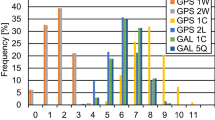Abstract
A CE-5T1 spacecraft completed a high-speed skip re-entry to the earth after a circumlunar flight on October 31, 2014. In addition to the strapdown inertial navigation system (SINS), a lightweight GPS receiver with rapid acquisition was developed as a navigation sensor in the re-entry capsule. The GPS receiver effectively solved the poor accuracy problem of long-term navigation using only the SINS. In contrast to ground users and low-earth-orbit spacecraft, numerous factors, including high altitude and kinetic characteristics in high-speed skip re-entry, are important for GPS positioning feasibility and were presented in accordance with the flight data. GPS solutions started at nearly 4900 km orbital altitude during the phases of re-entry process. These solutions were combined by an inertial measurement unit in a loosely coupled integrated navigation method and SINS navigation initialization. A simplified GPS/SINS navigation filter for limited resources was effectively developed and implemented on board for spacecraft application. Flight data estimation analyses, including trajectory, attitude, position distribution of GPS satellite, and navigation accuracy, were presented. The estimated accuracy of position was better than 42 m, and the accuracy of velocity was better than 0.1 m/s.






















Similar content being viewed by others
References
Barth A, Mamich H, Hoelscher B (2015) Post-flight analysis of the guidance, navigation, and control performance during Orion exploration flight test 1. AAS 1:15–134
Bauer FH, Parker JJK, Welch B, Enderle W (2017) Develo** a robust, interoperable GNSS space service volume (SSV) for the Global Space User Community. In: Proceedings of ION ITM 2017, Monterey, California, January 30–February 2, p 132–149
Capuano V, Blunt P, Botteron C, Tian J, Leclère J, Wang YG, Basile F, Farine P (2016) Standalone GPS L1 C/A receiver for lunar missions. Sensors 16(3):347. https://doi.org/10.3390/s16030347
Fan M, Hu XG, Dong GL, Huang Y, Cao JF, Tang CP, Li PJ, Chang SQ, Yu Y (2015) Orbit improvement for Chang’E-5T lunar returning probe with GNSS technique. Adv Space Res 56(11):2473–2482
Hogenauer EB (1981) An economical class of digital filters for decimation and interpolation. IEEE Trans Acoust Speech Signal Process 29(2):155–162
** SG, Luo O, Park P (2008) GPS observations of the ionospheric F2-layer behavior during the 20th November 2003 geomagnetic storm over South Korea. J Geodesy 82(12):883–892. https://doi.org/10.1007/s00190-008-0217-x
Kamil M, Chobtrong T, Günes E, Haid M (2014) Low-cost object tracking with MEMS sensors, Kalman filtering and simplified two-filter-smoothing. Appl Math Comput 235(4):323–331
Kaplan ED, Hegarty CJ (2005) Understanding GPS: principles and applications, 2nd edn. Artech House Inc., Boston
Kaygısız BH, Erkmen AM, Erkmen İ (2007) Enhancing positioning accuracy of GPS/INS system during GPS outages utilizing artificial neural network. Neural Process Lett 25(3):171–186. https://doi.org/10.1007/s11063-007-9036-y
Lee T, Long A, Berry K, Carpenter R, Moreau MC, Holt GN (2009) Navigating the return trip from the moon using earth-based ground tracking and GPS. In: 32nd annual AAS guidance and control conference, Colorado, United States, January 30 to February 4
Long A, Farahmand M, Carpenter R (2015) Navigation operations for the magnetospheric multiscale mission. In: International Symposium on Space Flight Dynamics, 25th, Munich, Germany, October 19–23, NASA Goddard Space Flight Center
Luo ZG, Zhang HB, Tang GJ (2014) Blended skip entry guidance for low-lifting lunar return vehicles. Acta Mech Sin 30(6):973–982. https://doi.org/10.1007/s10409-014-0086-x
Manzano-Jurado M, Alegre-Rubio J, Pellacani A, Seco-Granados G, López-Salcedo JA, Guerrero E, García-Rodríguez A (2014) Use of weak GNSS signals in a mission to the moon. In: The 7th ESA workshop on satellite navigation technologies and European workshop on GNSS signals and signal processing (NAVITEC), Noordwijk, The Netherlands, December 3–5, p 1–8
Muradyan P, Haase JS, **e FQ, Garrison JL, Voo J (2011) GPS/INS navigation precision and its effect on airborne radio occultation retrieval accuracy. GPS Solut 15(3):207–218. https://doi.org/10.1007/s10291-010-0183-7
Sahawneh LR, Al-Jarrah MA, Assaleh K, Abdel-Hafez MF (2011) Real-time implementation of GPS aided low-cost strapdown inertial navigation system. J Intell Rob Syst 61(1–4):527–544. https://doi.org/10.1007/s10846-010-9501-0
Tsui JBY (2004) Fundamentals of global positioning system receivers: a software approach, 2nd edn. Wiley, New York
Wang YL, Gao Y, Wang M (2014) The implementation of rapid acquisition algorithm for GPS weak signal by using FPGA. In: Sun J, Jiao W, Wu H, Lu M (eds) China satellite navigation conference (CSNC) 2014 Proceedings: Volume I. Lecture notes in electrical engineering, vol 303. Springer, Berlin
Xu R, Liu ZZ, Chen W (2015) Improved FLL-assisted PLL with in-phase pre-filtering to mitigate amplitude scintillation effects. GPS Solut 19(2):263–276. https://doi.org/10.1007/s10291-014-0385-5
Yang MF, Zhang G, Zhang W, Peng J, Wang Y, Wang XL, Chen CL, Du Y, Zhang ZF (2015) Technique design and realization of the circumlunar return and reentry spacecraft of 3rd phase of Chinese lunar exploration program. Sci Sin Technol 45(2):111–123. https://doi.org/10.1360/N092014-00484
Zanetti R (2015) Orion exploration flight test-1 (EFT-1) Absolute navigation performance. In: AAS/AIAA astrodynamics specialist conference, Vail, CO, United States, August 9–13
Zhang XH, Guo F, Zhou PY (2014) Improved precise point positioning in the presence of ionospheric scintillation. GPS Solut 18(1):5–60. https://doi.org/10.1007/s10291-012-0309-1
Acknowledgement
This work was supported by the National Natural Science Foundation of China (NSFC) under Grant Nos. 61601036 and 61421001.
Author information
Authors and Affiliations
Corresponding author
Rights and permissions
About this article
Cite this article
Wang, M., Shan, T., Ma, L. et al. Performance of GPS and GPS/SINS navigation in the CE-5T1 skip re-entry mission. GPS Solut 22, 56 (2018). https://doi.org/10.1007/s10291-018-0720-3
Received:
Accepted:
Published:
DOI: https://doi.org/10.1007/s10291-018-0720-3




